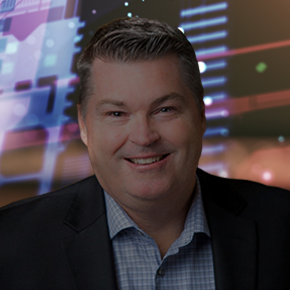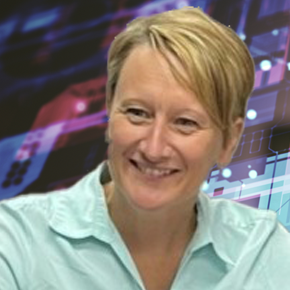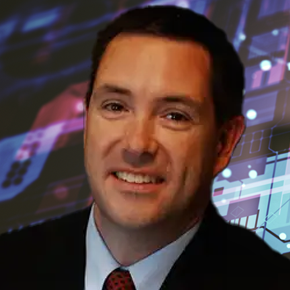August 10, 2022
Smart Products and the Supply Chain of Tomorrow

Transcript
Leah Archibald: Imagine a smart microwave that serves as the hub of your family’s meal planning, storing all your recipes and streaming cooking classes on demand, or a refrigerator that not only notifies you when you’re out of milk, but doubles as an incubator for growing fresh vegetables. These innovations aren’t merely pipe dreams for the future, they’re consumer demands that appliance manufacturers are putting into the pipeline today.
But with that futurized pipeline comes a whole new set of questions about how manufacturers are going to make these smart machines and where they’re going to get all the microchips to produce them. My guest is currently working on solving these problems for GE Appliances. Rob Lidster came to GE with over 25 years of experience in global supply chain procurement and operations. His resumé contains a diverse group of industries, from automotive to energy utilities, he was even the head of purchasing and logistics for a trendy musical instrument brand. The throughline of Rob Lidster’s career has been his passion for supply chain and he’s here today to help us see how building a supply chain is critical for the smart product the consumers are going to be asking for in the future. Rob Lidster, welcome to the podcast.
Rob Lidster: Thank you, Leah, thank you for that introduction.
Leah Archibald: Could you start by giving us a window into how consumer products are getting smarter?
Rob Lidster: Yeah, and you touched on it quite a bit in the opening. Consumers no longer look at cooking as a household chore, as much as a convenience. They are going to get a DoorDash delivery, or they are going to pick up something on their way home, and they just need a warming oven to heat it up.
So now we’re looking at what do our small appliances look like for the future, from the standpoint of both convenience and connectivity. You want to be out somewhere and preheat your oven so that when you walk in the door things have already started.
Leah Archibald: How do manufacturers need to get smarter in order to produce these smart products?
Rob Lidster: Understanding what it is that is going to allow the consumer to not only get full utilization of their product but want to buy our brand versus some of our competitors. So, we try to set ourselves aside from our competitors by one, having product available. We are getting smarter through better contracts and better negotiations with our supply base, not only at the tier one level of our supply base, but through the entire supply chain. We’ve had to go down to tier four, tier five and sometimes tier six levels just to ensure continuity of supply that we’ll be able to get the assemblies that will ultimately go into our final product.
Leah Archibald: Tell me a little bit more about why you need to do that. I imagine that it has something to do with the shortage of the components for these smart objects, especially microchips.
Rob Lidster: Yes. In medium and high-volume manufacturing, we need to keep these lines running. We don’t have the luxury of partially building something and then going back and retrofitting after the fact, especially where there’s stack up conditions where you need a wiring harness in order to put the backsplash on or even to put a door on. So, we need to make sure that for our engineers as they design, all the way to our hands that are assembling these appliances, that parts and assemblies are readily available for them, and they’re there to be put into the appliance as it’s coming down the line.
Leah Archibald: And how do you do that?
Rob Lidster: We’ve been making it a part of our requirement to ask our tier one suppliers to share with us: What is their value chain? What is the country that they’re going to be getting purchased parts from? Where are they going to make it? Where is their ship location? What port is it leaving from?
Leah Archibald: I bet they love that. [laughter]
Rob Lidster: Yeah, we’re all getting used to this new relationship, I can tell you. [laughter] It’s evolved over the last 24 to 28 months, for sure.
Leah Archibald: I make a joke of it because it sounds like you’re making them take a driving test with the amount of paperwork they’re filling out. But tell me really what it takes to get a supplier to give you all that information. Does it take being the size of GE? Or are other manufacturers able to renegotiate their supplier relationships in this fashion?
Rob Lidster: I think that’s a great question because sometimes it does require leverage. It does require a level of transparency that suppliers haven’t really been giving before. They’re having to tweak their processes internally because it was something that didn’t hit their radar screen. But at the end of the day, if the supplier wants the business bad enough in their revenue stream, they will partner with you, they’ll be transparent with you, and they’ll provide the information.
Leah Archibald: I bet it’s a process that’s painful at first, but then brings them a lot of value once it’s completed. Because perhaps they weren’t thinking about having visibility all the way down to the ends of their supply chain. And once they do, then they’re able to fulfill on their contracts. So it’s good for both of you.
Rob Lidster: Yeah, and I like how you used the term “value” because we do believe it is going to bring value. There are hidden costs in all of our processes. There’s hidden costs at GE Appliances. There’s hidden costs at our suppliers. And at the end of the day, if they have to expedite a component over the course of four or five, or six months, then that’s eating into their margin, that’s eating into their profits, and those are some hidden costs that can’t be absorbed anymore during this tough times that we’re in. So the value that I believe it brings to them is they will know at what point in time they may be losing money versus making money on a given part or an assembly. And we can check and adjust together versus having the difficult conversation asking for price relief.
Leah Archibald: You’re all getting a higher visibility into your data and the data that drives the bottom line.
Rob Lidster: That’s right.
Leah Archibald: I want to talk a bit about build-versus-buy decisions. You started out in the automotive industry where this has been a discussion for many decades. Do we build it in-house or do we buy it offshore? That’s challenging enough. But as we move into the internet of things, it’s not only the component supply chain that you’re worrying about, now there’s this supply chain of data. Fundamentally, has it made build versus buy decisions more complicated? Or is it the same decisions, but with greater stakes?
Rob Lidster: I would say it’s the latter. It’s greater stakes now. We’ve always dealt with disruptions. Trucks break down drivers or have flat tires. So there’s been delays and disruption in delivery of parts or services for a long time. But what we haven’t experienced is a hurricane followed by the Texas freeze followed by not only did the first truck break down, the second truck broke down. And by the way, it’s going to be eight or ten hours before we can find another driver because of the labor shortage.
And then you talked about data and internet of things. Now with the cyber security threats, you really have to pay attention to what is being put into the cloud. What’s being kept inside of your C drives on your computers and your systems? There’s a lot of extremely valuable information being passed around to multiple hands. So I would say that it is larger stakes now. And doing risk analysis and predictive risk modeling has really caught the attention of the CPOs and Chief Supply Chain Officers over the last three to five years. More so than it did in the first 5 or 10 years of my career.
Leah Archibald: Do you feel like your job is getting too hard? Tell me what type of data do you think is the most difficult to track and also to project into the future?
Rob Lidster: Supply chain has obviously gotten more complicated in the last 24 plus months. Fortunately, there’s GPS systems. What we have done is set up a control tower that can actually look at whether a ship is coming across the ocean, and if that’s going to take ten days or 14 days. And if it’s going to take 14 days to go into port A, we need to re-divert it and send it over to port B. That visibility into our supply chain is now being used more than it has in the past, because of the complications of getting it once it does hit the ports and getting it unloaded and on the land.
The consumer data is also important, as well as the reliability of that information. Because you may have a vacation home and we’re gathering information for a weekend or for a month and making some assumptions. And all of a sudden there’s a gap in usage. What’s happened? Is Leah no longer living in this residence? So understanding the repeatability and reliability of the information that we’re gathering is crucial.
Leah Archibald: Let’s shoot with some fun questions. What new product might be the most surprising to consumers?
Rob Lidster: We just came out with a mushroom incubator that you can actually use to make mushrooms. And we’re coming out with a tabletop smoker now.
I would say from our core business, it’s complementing what the consumers are looking for. Like for example, an oven with an air fryer in it. We have a refrigerator that has a Keurig coffee maker on the front. Who would have ever thought you would have a refrigerator with a heater on it? The complexity of our products and the demands of our products by our consumers is just continuing to grow and grow.
Leah Archibald: Tell me how you plan for servicing these products? Because I imagine the more complexity you bake into a product – for example a refrigerator that’s managing both cold and hot – the more you have to train your stream of service professionals. So where does that fit in into your product lifecycle management?
Rob Lidster: That’s a great question as well. So that is included as part of our new product introduction. We do serviceability curves as well. How easy is it for the technician to get to the heater versus packaging it so tight that you have to take the outer panel off. So that part of the serviceability is incorporated into our designs as we launch our products. And then from a service part availability, we have written into our contracts for a certain amount of time that our suppliers need to be able to provide service parts for that particular model. That is all incorporated as part of our upfront metrics in our NPI process before we even go into production.
Leah Archibald: This has all been really stimulating. I’m sorry that people can’t yet listen to our podcast on their microwave! But for right now I’m glad they get a chance to listen to it on their phone [laughter]. But seriously, I’m very glad that we have this capability – this window into data – so we can not only see what’s going on around us right now, but have a little window into what’s going to happen in the future.
Rob Lidster: Yeah. Being able to predict any of the supply chain constraints means it’s the OEM and the customer that’s going to win. The more we can predict supply chain disruptions, the better we’ll be able to compete with our competition.
Leah Archibald: Rob Lidster, it’s been a pleasure speaking with you today. Thank you so much.
Rob Lidster: Thank you, Leah.







